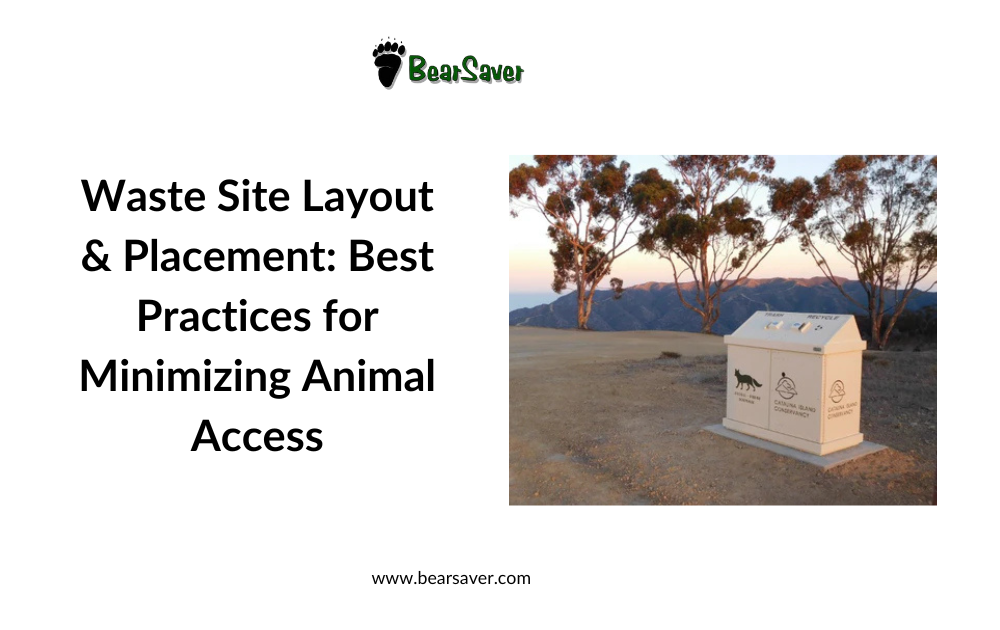Waste Site Layout & Placement: Best Practices for Minimizing Animal Access
Posted by Securr Blogger on
Managing waste in areas where wildlife is active requires more than tough containers. The overall layout, placement, and design of your waste collection sites play a major role in reducing animal intrusion, preventing property damage, lowering cleanup costs, and promoting safe human–wildlife coexistence. Whether you manage parks, commercial developments, municipalities, or multi-unit properties, proper site planning is essential.
Below are the most effective practices for creating waste sites that naturally discourage animals — before they ever make contact with your containers.
1. Select Locations That Minimize Wildlife Attraction
Placing waste sites in the wrong area can unintentionally attract animals. Instead, choose locations that offer:
High Visibility
Animals are less likely to approach areas with regular human activity. Position waste enclosures near walkways, parking lots, or lit gathering areas rather than near vegetation or secluded corners.
Distance From Food Sources
Waste sites should be placed 20–30 feet away from picnic areas, outdoor dining, kitchens, feeding stations, grills, or break areas. This separation helps prevent animals from associating food with human structures.
Stable, Level Ground
A secure foundation prevents bins from tipping or shifting — a common opportunity for animals to exploit even secure containers.
2. Avoid Vegetation & Natural Cover
Bushes, tree lines, stacked materials, or landscape elements can give animals a sense of security while approaching a waste site.
To deter them:
• Maintain open sight lines around the enclosure.
• Keep vegetation trimmed within 10–15 feet of the site.
• Avoid placing bins near tree trunks, where climbing animals may perch or jump from.
This discourages animals from lingering near waste areas.
3. Incorporate Adequate Lighting & Human Presence
Lighting doesn’t just help guests and staff — it also discourages nocturnal wildlife.
• Install dusk-to-dawn area lighting.
• Position waste sites near paths that stay active into the evening.
• Consider motion-activated lights for remote areas.
Animals quickly learn which areas feel risky to approach.
4. Use Truly Animal-Resistant Waste Enclosures
Placement matters — but only in combination with reliable containers. Wildlife can pry open lids, chew through plastic, or tip ordinary bins with surprising strength.
This is why many property managers incorporate animal-resistant metal enclosures.
Example Highlight:
The BearSaver CE-Series Triple Trash/Recycling Enclosure (Model CE340-CH) is a popular choice for parks, commercial settings, and resorts. It features reinforced steel construction, top-loading chutes, tamper-resistant access, and rodent-proof engineering — making it a strong companion to proper waste-site planning.
5. Space Bins to Prevent Animal Leverage
When containers are too close together, animals have an easier time climbing between them, using one bin as leverage to access another.
For best results:
• Space enclosures at least 2 feet apart.
• Ensure lids open freely without obstruction.
• Anchor enclosures in high-bear or high-wind regions.
Good spacing also supports sanitation staff efficiency and prevents overcrowding.
6. Design for Serviceability Without Reducing Security
Often, wildlife access happens simply because someone forgot to close or latch a bin. A well-designed waste site helps eliminate that risk.
• Ensure maintenance crews have clear, direct access for efficient servicing.
• Choose enclosures with dedicated service doors or rear-access panels.
• Place enclosures where trucks can approach without workers needing to reposition bins.
Good design ensures bins stay latched and secure after every pickup.
7. Add Secondary Deterrents When Necessary
For regions with heavy wildlife pressure, consider integrating additional features:
• Low fencing or gating around waste sites
• Concrete pads to prevent shifting
• Signage reminding guests and staff to latch lids
• Odor-control liners or sealed bags
These elements create a second line of defense around even the most secure containers.
8. Train Staff & Educate Users
Human behavior ultimately determines whether the system succeeds.
Train all personnel on:
• Keeping lids closed and latched
• Never leaving waste bags outside enclosures
• Immediately reporting overflow or damage
• Using proper bagging to reduce odors
Even the strongest enclosure cannot compensate for misuse — user awareness is key.
A Secure Site Starts With Smart Layout + Reliable Equipment
By combining strategic waste-site placement with durable, animal-resistant containers, your organization can dramatically reduce wildlife conflicts, litter, and damage. Proper layout supports safety, protects wildlife, and maintains a cleaner, more professional environment.
For high-quality enclosures that complement any well-designed waste site, contact BearSaver:
📞 800.851.3887
📧 sales@bearsaver.com
🌐 bearsaver.com

